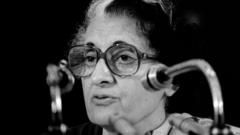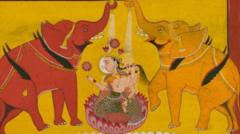Indira Gandhi's declaration of Emergency in June 1975 stands as a pivotal moment in India's democratic history, characterized by widespread civil rights violations, political oppression, and the silencing of dissent, leading to significant repercussions still felt today.
The Shadows of Emergency: India’s Democracy Under Siege

The Shadows of Emergency: India’s Democracy Under Siege
Reflecting on the dark chapter of India's Emergency from 1975 to 1977, this article examines the suspension of civil liberties and the resulting political purges that reshaped the nation.
At midnight on June 25, 1975, India, a burgeoning democracy, faced a stark transformation. Prime Minister Indira Gandhi declared a nationwide Emergency, resulting in major restrictions on civil liberties, the detention of opposition leaders, and media censorship. The catalyst for this authoritarian shift was a controversial ruling by the Allahabad High Court, which annulled Gandhi's 1971 parliamentary victory due to electoral fraud allegations. As public unrest grew, driven by opposition leader Jayaprakash Narayan, Gandhi invoked "internal emergency" under Article 352 of the Constitution, citing threats to national stability and effectively delegitimizing any dissent.
Historian Srinath Raghavan, in his recent examination of this era, illustrates that while the Constitution provided expansive emergency powers, what followed was an unprecedented augmentation of executive authority, severely undermined by a lack of judicial oversight. Over 110,000 individuals were arrested, including key figures of various political factions. State repression silenced dissenters, with prisons crowded and reports of torture commonplace—particularly in Uttar Pradesh, where no judgments against unlawful detentions were made.
The Emergency also triggered an annihilation of personal freedoms through a ruthless family planning initiative, coercing around 11 million sterilizations, many believed to be orchestrated by Sanjay Gandhi, the Prime Minister’s son. Communities were traumatized as the poorest were compelled to participate in the sterilization programs, with financial incentives driving many to compliance. This draconian effort often left families devastated, leading to a societal landscape marred by state-sanctioned violence.
Furthering the authoritarian grip, the regime initiated demolitions across Delhi, erasing the homes of approximately 700,000 impoverished residents in a campaign described by critics as social cleansing. The gentrification efforts culminated in violent retaliations against those attempting to resist their forced displacement, particularly severe in neighborhoods like Turkman Gate, where protests turned deadly.
Simultaneously, the media experienced unprecedented censorship as the government's heavy-handed restrictions muted critical reporting. Printed space was used to signify the impact of censorship, leading notable publications to circulate blank columns as a form of protest against the suppression of speech. Journalists were expelled for defying stringent guidelines, highlighting the regime's desire to control the narrative.
Sanjay Gandhi's influence on domestic policy also resonated through a five-point plan that merged personal ideology with state governance, significantly impacting the lives of Indian citizens. A crackdown on unions followed, stifling dissent from labor movements and effectively obliterating working-class political engagement.
While the Emergency was marked by oppression, some argued that it introduced a rare semblance of order. Trade resumed, strikes diminished, and economic growth was revived after stagnation. Yet, this façade of stability came at an incalculable cost to democracy, as many in the middle class refrained from opposing the regime.
Once the Emergency concluded in March 1977 and elections were called, Gandhi and her Congress party faced a crushing defeat, prompting the new Janata government to enact numerous reversals of her policies. Nonetheless, historians have argued that the period exposed vulnerabilities within Indian democracy and revealed how swiftly it could be undermined from within, even under legal justifications.
The Emergency has since been contextualized in India as a cautionary tale that warns against the hero worship of political leaders. B.R. Ambedkar's warnings against surrendering freedoms to charismatic authority resonate strongly today, serving as a stark reminder of democracy's fragility—a concept that remains crucial in contemporary discourse as voices question the enduring impact of this historical episode.



















